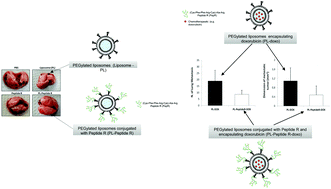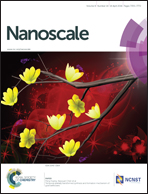CXCR4-antagonist Peptide R-liposomes for combined therapy against lung metastasis†
Abstract
The chemokine CXCL12 activates CXCR4, initiating multiple pathways that control immune cell trafficking, angiogenesis and embryogenesis; CXCR4 is also overexpressed in multiple tumors affecting metastatic dissemination. While there has been great enthusiasm for exploiting the CXCR4-CXCL12 axis as a target in cancer therapy, to date the promise has yet to be fulfilled. A new class of CXCR4-antagonist cyclic peptides was recently developed and the compound named Peptide R was identified as the most active. With the intent to improve the efficacy and biodistribution of Peptide R, stealth liposomes decorated with Peptide R were developed (PL-Peptide R). In vitro PL-Peptide R efficiently inhibited CXCR4-dependent migration and in vivo it significantly reduced lung metastases and increased overall survival in B16-CXCR4 injected C57BL/6 mice. To evaluate if PL-Peptide R could also be a drug delivery system for CXCR4 expressing tumors, the PL-Peptide R was loaded with doxorubicin (DOX) (PL-Peptide R-DOX). PL-Peptide R-DOX efficiently delivered DOX to CXCR4 expressing cell lines with a consequent decrease in the DOX IC50 efficient dose. In vivo, B16-CXCR4 injected C57BL/6 mice treated with PL-Peptide R-DOX developed fewer lung metastases compared to PL-DOX treated mice. This work provides the proof-of-concept to prevent metastasis by using combined nanomedicine.


 Please wait while we load your content...
Please wait while we load your content...